
The year is 1905, and the children of Fairmont W.V. can hardly hold back the excitement. Today is Circus Day! Every year in Fairmont, large or small circuses come and entertain the masses with all kinds of stunts, animal acts, and freak shows. The parade from the train station to the fairgrounds on the south side is part of the spectacle.
This year one of the bigger circuses will arrive. The Barnum and Bailey Circus is straight from a sold-out engagement in Pittsburgh, Penn.
The famous duo no longer managed the Barnum and Bailey Circus it was named for. They both had passed, and others managed the organization.
When the train arrived on that day, Sept. 4, 1905, the crowd of onlookers was told there would be no parade. The owners felt that with the show growing so large, there would be no way to unload everything and still be ready for the first performance at 2:00. I’m sure if you had been there, the silence from this announcement would have been deafening.
The train was unloaded, and they went onto South Side park. The chuckwagons that had arrived before the train got in were already up and running. The performers were hungry and needed a good meal to help them get ready for the long day ahead. Two performances were scheduled, one at 2:00 and one at 8:00.
The big top was raised with the elephant’s help, and the tents for concessions were almost ready to go. The performers started to prepare themselves.
Meanwhile, an exceptional performance getting ready was not on the bill. Because of having to cancel the popular parade, it was announced that two free tightrope spectacles, high in the air, would be performed. I’m sure it was scary but thrilling. The circus would be in town for two days before packing up and moving on.
Therefore the fun and excitement had come and gone, and Fairmont would have to wait another year to see them again. They did return in 1906 as Barnum and Bailey, but this would be the last year under that name. The larger, more popular Ringling Bros Circus would buy them up.
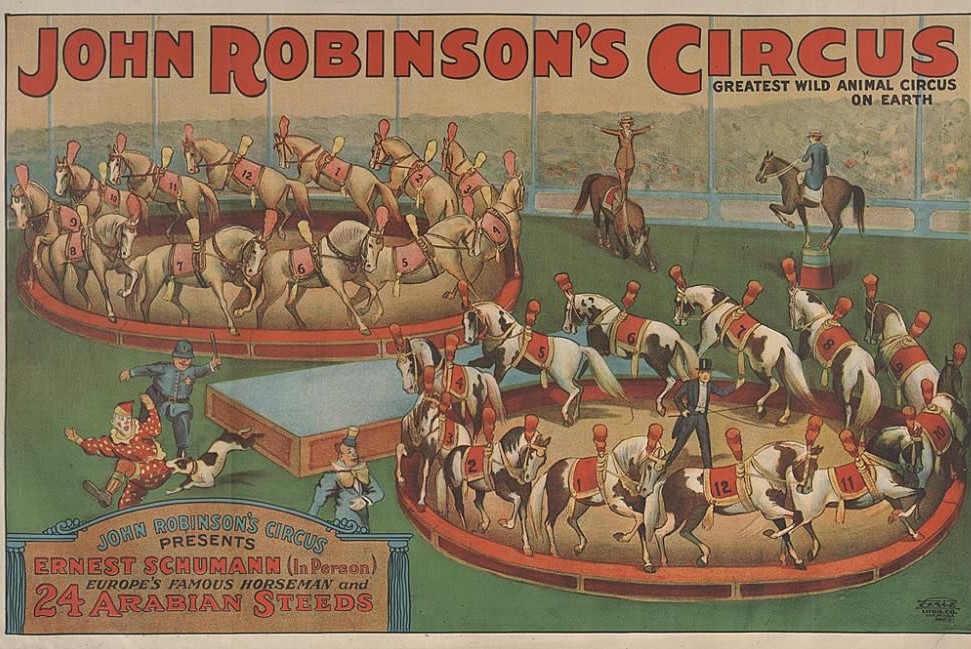
The John Robinson Circus was up next. The year 1907. After the customary parade through town, four tents were erected at South Side Park. Three smaller tents for concessions and side shows and wares to be sold after the show. The fourth tent, of course, was the Big Top. It was so big it was said to be able to hold 10,000 people at one time. This was unheard of. The new act that drew the most attention at the time was the bicycle feats performed at center stage. Riding up and down ladders, popping wheelies, and riding backward on the front tire.
The show amazed and astounded. Children were spellbound, watching all the acrobats swing high in the air. The wild animals scared yet delighted the crowd.
When the shows came to town now, the local merchants would join in the fun and offer circus day sales. Merchants such as Jones Department Store, Cranes Drug, and many others cashed in on the popularity.
Furthermore, with the growing popularity of the circus coming to town every year, other nefarious people also tried their hand at making money. It would seem at the time, there were two different types of circus shows; the grifting shows and the clean shows. The grifting shows would show up in the city, and their acts would include illegal gambling, pickpockets, and burglaries. They only brought these shows to cities where they knew the police could be bought in. The clean shows would only be for fun and pleasure, no trouble. The John Robinson Circus was a clean show. Who knows, next year may bring something different!
Circus Day again, a smaller yet well-known circus came to town called Adam ForePaugh and Sells Brothers United Shows this year. It happened in May of this year, 1910.
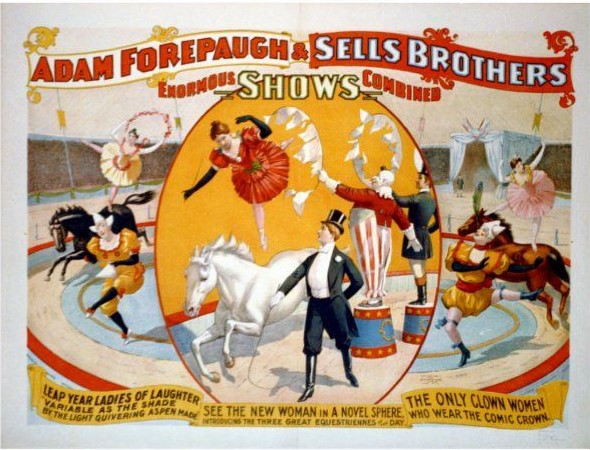
This troupe would travel 20,000 to 30,000 miles each year and only stop to perform in larger cities. Fairmont, at the time, because of the coal boom, was considered a larger city. They would try to go no further than 75 miles a day.
The advance man [the person a circus sends ahead to get the townspeople ready for what’s coming] had already put up the handbills and got the excitement going. The circus promised a giant train loaded with new acts and exotic animals. They owned the coming train and had added new sleeping cars, more cars for horses, boxcars, and larger flatbed cars to carry the fancy new wagons that the zebras and elephants would pull. The train also boasted a Palace Car that would house The Great Sixty-One Horse Team, one of the newest attractions.
The parade was a grand affair. Both sides of the streets were packed with young and old marveling at the giant elephants dressed to impress and pulling the brightly colored wagons. The performers walked and skipped to the music that played from two calliopes. The clowns made balloon animals and handed them to the kiddies. They made their way to the fairgrounds, and for the next three days, patrons from Fairmont and the surrounding cities were entertained. Sadly this would be the last year also for this circus under this name. The larger entertainment companies were buying, the smaller troops up.
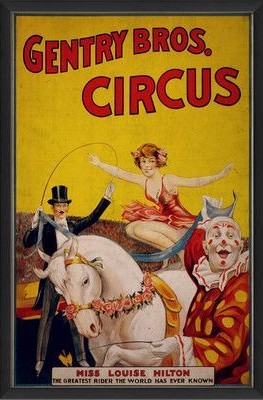
June 27, 1911, The Gentry Bros Circus was making a stopover in Fairmont and would put on a show later that evening at the fairgrounds. This was just 1 of 4 troops that entertained across the country. The show at this time was mainly a dog and pony show. The Gentry Bros started out training their own dogs to jump through hoops and dance. The ponies would also dance and jump over barrels and do counting tricks. At this point, they had no human acts. The year before, though, they had added 20 baby elephants to divide between all four troops. The elephants, always a draw, helped make the show a success.
The Gentry Bros show was billed as a “Clean and Moral Show.” They would continue to provide good entertainment for a few more years and even add some human acts. Their luck ran out though the day before the stock market crash, the Gentry Bros Show went bankrupt in Paris, Texas, and closed. It tried in 1931 to come back and never made it. The citizens of Fairmont were very lucky to have had the pleasure of their shows.
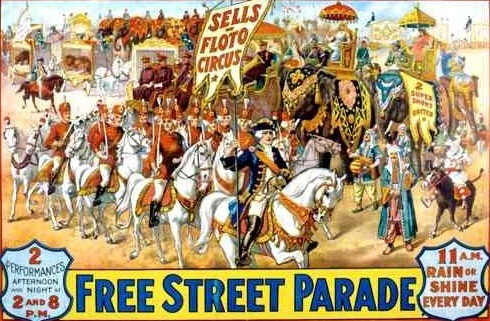
This next year had a sort of twist happening in Fairmont. The annual Fairmont fair was ongoing, along with the Sells Floto circus arriving. Now would the good citizens of Fairmont attend both? Would they have the money to throw at two big events?
It was September 19, 1913, and the summer was ending when the fliers were put up all over town announcing the arrival of the Circus. On the bill, an act was noted to have a horse named “Luckett” that could jump 6ft in the air. He was a beautiful black thoroughbred. Im sure people just had to know if this was true. Their curiosity won out because the attendance at the circus was as good as ever. This year was like Christmas, by having both events going at the same time.
The Fairmont Elks organization was next up, and they always did charity work for the community. They were known for helping those in need. They had various ways of raising money and always did it in a very inventive way.
The year was 1914, and this year would prove to be the biggest undertaking for charity yet.

Bert S. Leopold was the chairman of this program, and Ed Slack was the stage manager. Together they oversaw all the components of this venture.
They brought 20 builders to erect the 4ft high stage as a center ring. They built a bandstand and concession booths. The Fairmont Armory would hold this show for three days. They spared no expense. They brought in snakes and animals from the east. They hired performers to entertain at the sideshow.
Like professional circuses, they plastered handbills all over town, advertised in the newspaper, and put posters in store windows.
They sold candy, pink lemonade, and circus wares to the crowd, This was as good as any real circus that had come to town, and the best thing was that after expenses, all the proceeds went to charity. Today we should work as hard as they did to support our community.
The year 1915 brought not one, but two circus shows to town. One was internationally known. The other was making a name for itself by having a 19-year-old boy whose name would become famous in the animal realm.
The famous Ringling Bros Circus was coming to town. This year, they prepared to have a huge extravaganza in the center ring. The presentation would be “Soloman and Queen of Sheba.” Twelve Hundred and Fifty performers would take part in this show. The costumes were specially made for it. They sparkled and shined. The animals are adorned with glittery harnesses. It would rival a broadway show, and to think it was in a small town in West Virginia would blow your mind.
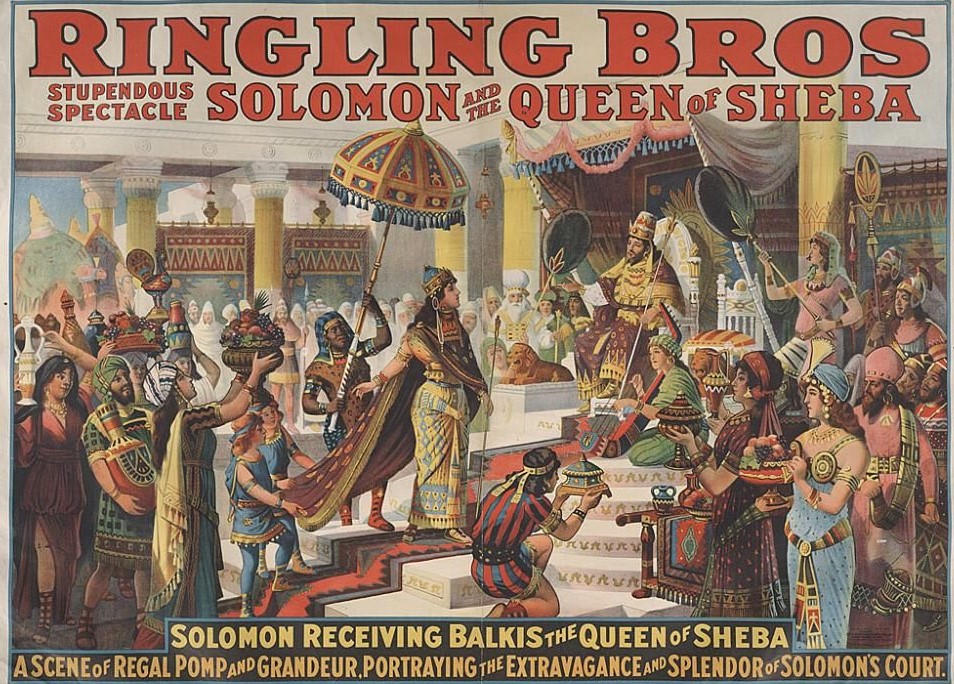
They also brought Josephine Clark and her white stallion Silver King from Britain. Her act involved riding on the back of her horse while doing ballet moves such as a prima ballerina. It is said she traveled with 14 trunks of handmade costumes and dresses. I’m sure it was a show not to miss.
The second show of the year came from the Carl Hagenbeck-Wallace Circus. Mr. Hagenbeck was from Germany and was billed as the first man to break wild animals for performances at all World Fairs in the United States. His name would go on to be synonymous with wild animal training.
They came into town it was stated on a mile-long train that was in three sections. Their show also had three rings, two elevated stages, and four hundred performers from almost every country globally. I’m sure it was amazing.
Two large shows in one year, Fairmont was a very busy city that year.

Step right up and buy your ticket. Prepare to be awed with all three rings showing different acts simultaneously. Ringlingling Bros was back a year later. They had grown, and as you can see from the poster, they were ready to give you your money’s worth. Cinderella was being done this year, and you would feel like you were in fairy-tale land.
Local railroad personnel stated that “this was the largest organization to visit locally.”
They were so huge a company that they called themselves Ringlingville.
The parade through Fairmont was said to be 3 miles long. They were accompanied by two musical calliopes and a marching band.
The sideshows were the first tents at the fairgrounds to give a small taste of things to come. The rest of the performers were fed and then hurried to dress and get ready. I can imagine the folks of this city were bubbling with excitement.
The time is 2:00, and the first performance begins. On the largest stage ever erected in a circus, The Cinderella spectacle begins. It would be a giant pantomime with a cast of many. The ballet section of the show had three hundred girls dressed as sprites. When the performance was over, the show continued with 400 different acts. Can you imagine trying to watch them all at once?
They had the world’s smallest woman aerialist and 300 Chinese acrobats. They had Silas Green and his entire family of cousins and aunts’ dogs and horses doing a laughable act of riding stunts.
Sixty clowns performed all over the tent, and elephants did a cabaret number. Im sure at the end of the day, patrons had seen things they had never seen before!
Over the next few years, more circuses would bring never-before-seen acts to Fairmont. There was the Sparks Circus that had elephants that did a Shimmy Dance. The Solo circus, the Al G. Barnes Wild Animal Circus, boasted to have had an elephant bigger than the famous Jumbo, who had been killed earlier that year. His elephant would weigh a ton and a half more and boast six feet long tusks.
After Ringling Bros bought out the Barnum and Bailey circus, they renamed themselves using both names and, for one last time in 1921, they came to Fairmont and gave them”The Greatest Show on Earth!”
Im not sure if they ever came back to town, but if they did, I’m sure it was just as magnificent.
In Mannington, W.V., in 1922, a circus arrived at their fairgrounds. It advertised freaks and wonders of nature. It was the Gallagher-Judd Circus. I couldn’t find too much on them, but it did say they were bringing the Wild Man Of Borneo, the smallest woman in the world and the largest Man. They would hold two chariot races around the arena and produce the Poor Mans Fire Deptmanent Act. When they came in on the train and unloaded, they gave the residents of Mannington a fabulous parade that started at Center St., went to High St, to Beatty Ave., and then to the circus grounds at the corner of Clarksburg and Center St.
You got all this entertainment for the great price of 75 cents. Wow, how I would have loved to live in that era.
Now with Fairmont, a much smaller city, we no longer get great shows like these. I remember the circus that would often come to the Fairmont Armory. It was smaller, yet we kids loved it.
I hope this article will help you see how much we were considered a larger town at one time. Tell me some of your circus adventures below in the comment section if you feel like it. Tell me what you thought of the article, and if there is a story you would like to read about Fairmont, drop me a hint.
Thank you for taking the time to read my blog, and remember: History is the spine of America; not learning from it would make us collapse and fall!
.
